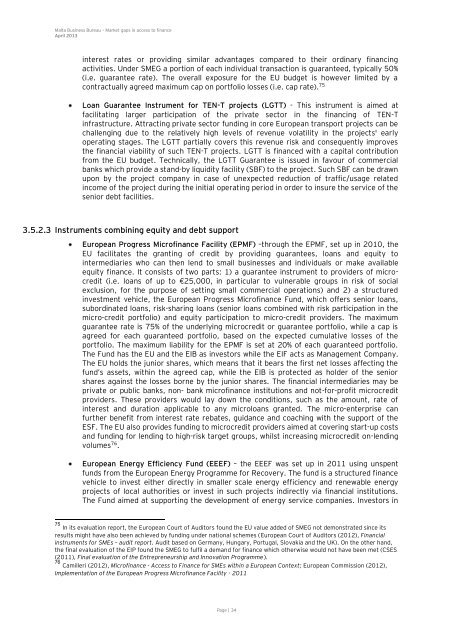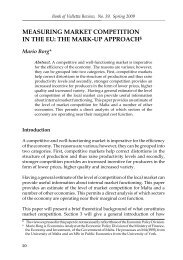Market Gaps on Access to Finance - Bank of Valletta
Market Gaps on Access to Finance - Bank of Valletta
Market Gaps on Access to Finance - Bank of Valletta
Create successful ePaper yourself
Turn your PDF publications into a flip-book with our unique Google optimized e-Paper software.
Malta Business Bureau – <str<strong>on</strong>g>Market</str<strong>on</strong>g> gaps in access <strong>to</strong> finance<br />
April 2013<br />
interest rates or providing similar advantages compared <strong>to</strong> their ordinary financing<br />
activities. Under SMEG a porti<strong>on</strong> <strong>of</strong> each individual transacti<strong>on</strong> is guaranteed, typically 50%<br />
(i.e. guarantee rate). The overall exposure for the EU budget is however limited by a<br />
c<strong>on</strong>tractually agreed maximum cap <strong>on</strong> portfolio losses (i.e. cap rate). 75<br />
Loan Guarantee Instrument for TEN-T projects (LGTT) - This instrument is aimed at<br />
facilitating larger participati<strong>on</strong> <strong>of</strong> the private sec<strong>to</strong>r in the financing <strong>of</strong> TEN-T<br />
infrastructure. Attracting private sec<strong>to</strong>r funding in core European transport projects can be<br />
challenging due <strong>to</strong> the relatively high levels <strong>of</strong> revenue volatility in the projects' early<br />
operating stages. The LGTT partially covers this revenue risk and c<strong>on</strong>sequently improves<br />
the financial viability <strong>of</strong> such TEN-T projects. LGTT is financed with a capital c<strong>on</strong>tributi<strong>on</strong><br />
from the EU budget. Technically, the LGTT Guarantee is issued in favour <strong>of</strong> commercial<br />
banks which provide a stand-by liquidity facility (SBF) <strong>to</strong> the project. Such SBF can be drawn<br />
up<strong>on</strong> by the project company in case <strong>of</strong> unexpected reducti<strong>on</strong> <strong>of</strong> traffic/usage related<br />
income <strong>of</strong> the project during the initial operating period in order <strong>to</strong> insure the service <strong>of</strong> the<br />
senior debt facilities.<br />
3.5.2.3 Instruments combining equity and debt support<br />
European Progress Micr<strong>of</strong>inance Facility (EPMF) –through the EPMF, set up in 2010, the<br />
EU facilitates the granting <strong>of</strong> credit by providing guarantees, loans and equity <strong>to</strong><br />
intermediaries who can then lend <strong>to</strong> small businesses and individuals or make available<br />
equity finance. It c<strong>on</strong>sists <strong>of</strong> two parts: 1) a guarantee instrument <strong>to</strong> providers <strong>of</strong> microcredit<br />
(i.e. loans <strong>of</strong> up <strong>to</strong> €25,000, in particular <strong>to</strong> vulnerable groups in risk <strong>of</strong> social<br />
exclusi<strong>on</strong>, for the purpose <strong>of</strong> setting small commercial operati<strong>on</strong>s) and 2) a structured<br />
investment vehicle, the European Progress Micr<strong>of</strong>inance Fund, which <strong>of</strong>fers senior loans,<br />
subordinated loans, risk-sharing loans (senior loans combined with risk participati<strong>on</strong> in the<br />
micro-credit portfolio) and equity participati<strong>on</strong> <strong>to</strong> micro-credit providers. The maximum<br />
guarantee rate is 75% <strong>of</strong> the underlying microcredit or guarantee portfolio, while a cap is<br />
agreed for each guaranteed portfolio, based <strong>on</strong> the expected cumulative losses <strong>of</strong> the<br />
portfolio. The maximum liability for the EPMF is set at 20% <strong>of</strong> each guaranteed portfolio.<br />
The Fund has the EU and the EIB as inves<strong>to</strong>rs while the EIF acts as Management Company.<br />
The EU holds the junior shares, which means that it bears the first net losses affecting the<br />
fund’s assets, within the agreed cap, while the EIB is protected as holder <strong>of</strong> the senior<br />
shares against the losses borne by the junior shares. The financial intermediaries may be<br />
private or public banks, n<strong>on</strong>- bank micr<strong>of</strong>inance instituti<strong>on</strong>s and not-for-pr<strong>of</strong>it microcredit<br />
providers. These providers would lay down the c<strong>on</strong>diti<strong>on</strong>s, such as the amount, rate <strong>of</strong><br />
interest and durati<strong>on</strong> applicable <strong>to</strong> any microloans granted. The micro-enterprise can<br />
further benefit from interest rate rebates, guidance and coaching with the support <strong>of</strong> the<br />
ESF. The EU also provides funding <strong>to</strong> microcredit providers aimed at covering start-up costs<br />
and funding for lending <strong>to</strong> high-risk target groups, whilst increasing microcredit <strong>on</strong>-lending<br />
volumes 76 .<br />
European Energy Efficiency Fund (EEEF) – the EEEF was set up in 2011 using unspent<br />
funds from the European Energy Programme for Recovery. The fund is a structured finance<br />
vehicle <strong>to</strong> invest either directly in smaller scale energy efficiency and renewable energy<br />
projects <strong>of</strong> local authorities or invest in such projects indirectly via financial instituti<strong>on</strong>s.<br />
The Fund aimed at supporting the development <strong>of</strong> energy service companies. Inves<strong>to</strong>rs in<br />
75 In its evaluati<strong>on</strong> report, the European Court <strong>of</strong> Audi<strong>to</strong>rs found the EU value added <strong>of</strong> SMEG not dem<strong>on</strong>strated since its<br />
results might have also been achieved by funding under nati<strong>on</strong>al schemes (European Court <strong>of</strong> Audi<strong>to</strong>rs (2012), Financial<br />
instruments for SMEs – audit report. Audit based <strong>on</strong> Germany, Hungary, Portugal, Slovakia and the UK). On the other hand,<br />
the final evaluati<strong>on</strong> <strong>of</strong> the EIP found the SMEG <strong>to</strong> fulfil a demand for finance which otherwise would not have been met (CSES<br />
(2011), Final evaluati<strong>on</strong> <strong>of</strong> the Entrepreneurship and Innovati<strong>on</strong> Programme).<br />
76 Camilleri (2012), Micr<strong>of</strong>inance - <strong>Access</strong> <strong>to</strong> <strong>Finance</strong> for SMEs within a European C<strong>on</strong>text; European Commissi<strong>on</strong> (2012),<br />
Implementati<strong>on</strong> <strong>of</strong> the European Progress Micr<strong>of</strong>inance Facility - 2011<br />
Page | 34







